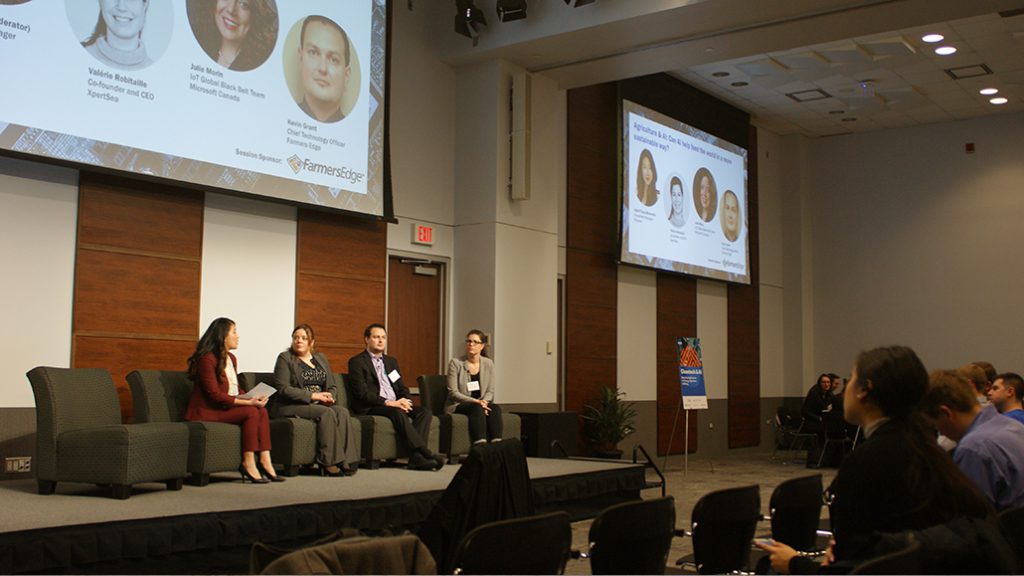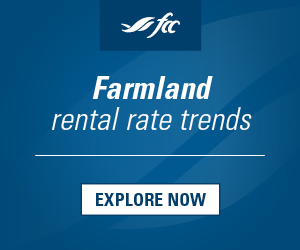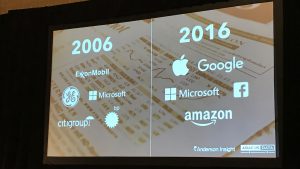Technology and the perfect acre
ARTIFICIAL INTELLIGENCE IN PRECISION AGRICULTURE

USING TECHNOLOGY TO aid farmers in getting the most efficient farm is being pioneered by companies, agronomists, and farmers all over the world. And now, researchers are experimenting with taking precision agriculture, in particular data analysis, to the next level through the use of artificial intelligence.
Recently, Toronto based company MaRS held a symposium titled “Cleantech & AI: Next-Gen Applications for Energy, Agriculture, & Mining”. Great minds from the agriculture, mining, and energy sectors came together to discuss what impact artificial intelligence could have on their respective fields. There to help crack the case for agriculture was Julie Morin, Kevin Grant, and Valérie Robitaille. The panel was moderated by Ingrid Fund.
Precision Agriculture is an important part of modern agriculture. Farmers know their operations best, but when it comes to maximizing profit, it sometimes takes thinking outside of the box to find that magic number. Farmers have the ability to add even more success to their business if they explore numbers in areas most wouldn’t think to look.
We tend to think of operations in big-picture terms. Overall, how did my corn do this year? Overall, how did my profits fare this year?
THE NUMBERS
One of the tricks of precision agriculture is to break down the numbers as small as possible. Kevin Grant, chief technology officer of Farmer’s Edge, explained that, from his own experience, even something as small as tractor speed can affect the profit of a farm. “You set the speed of the tractor at 5.1miles an hour, and you just went. We know in some cases that’s too fast and in other cases that’s too slow. Most guys won’t be adjusting,” Grant says.
While tractor speed might only increase your profit by 20 or 30 cents per acre, for large acreage operations that can have a huge impact on your bottom line profit. It’s factors like tractor speed that can determine the difference between a good profit and a great profit.
Making small changes to optimize your profit on an operation is knowledge farmers can seek out on their own time. However, we can take away that one step to make gaining information even easier for farmers. If farmers were willing, creating a program that compiles data and finds solutions that farmers weren’t even looking for is possible. The software would be able to help with real-time findings and suggest small changes. This wouldn’t just require a single farm’s data though, imagery, weather mapping, and a compilation of data from other farms would boost the capabilities.
Utilizing the imagery, the program has the potential to alert farmers of an event occurring in the field that he, or she, might not have noticed prior.
What if we could take it a step further and have the technology act in predictive ways? According to Grant, that’s already on the way.
“Farmers could go out and they can pro-actively spray. And you can just spot spray, so not go out and cover the whole field, but spray 10 or 20 acres and progress towards that perfect strategy on an acre,” he says. “You’ll never get to perfect, but you will progress.”
Technology is perhaps best at finding errors in our ways. If you let a program run, you’re bound to run into the errors that are happening. The artificial intelligence that we’re talking about is no different, and implementing it onto the farm could save headaches for operations everywhere. It’s not just about fixing problems, it’s about finding them.
“It’s easy to look back and do descriptive analytics in the fall,” Grant says, “it’s difficult to make those decisions in advance, but you want to provide a farmer with as much data, or as much information as possible, and in an actual on-time alert.”
ACCESS
For companies working in developing countries, at times without internet access, how can they help to create a program for farmers without the data they need? Even in Canada, rural communities struggle to access high speed connections, putting nsome company’s tech offerings out of reach.
Valérie Robitaille, co-founder and CEO of XpertSea, helped address that issue head-on during the panel. “Are we going to collect data from farmers all around the world before we can have an application that’s actually useful? That’s not possible, so we’ll have to be creative and try ways to yes, gather enough data, but is there some things that we can do with the technology to synthetically increase the data.”
Getting technology on farms won’t just affect data collection. Julie Morin, part of Microsoft’s Internet of Things team, also spoke to the importance of getting technology onto the farm for succeeding generations.
“I think one of the challenges that agriculture customers have is lack of staff or people to succeed them. Anything that helps them to be more productive, to help them rely less on people resources may be very helpful,” Morin says.
While the current state of agriculture places most farmers above 55, a new generation of farmers is on the way. And they will be utilizing technology even more than we see today. We’ve gone from personal assistants being reserved for the rich, to every individual having one living within their phone. Technology is more present than ever before, and it’s up to current farmers to help find a place for it in their operations.
QUESTIONS TO ASK
One of the first questions that should be asked with data collection is, who owns the data of the operation?
Data ownership establishes who has legal rights over digital information. Julie Morin, part of Microsoft’s Internet of Things team, said data ownership was one of the most frequently discussed topics with potential customers. “It’s a very popular topic because everyone wants to own the data. This is probably the single biggest conversation that we get into with customers, is who’s going to own the data.”
We shouldn’t only be discussing data ownership. Privacy is a large concern for any company that collects, stores, and shares data.
According to Kevin Grant, chief technology officer of Farmer’s Edge, data can be kept anonymous. “You can quickly aggregate this data and see which canola variety did best in your region while anonymizing the data, so you don’t know if it’s your neighbour, or this guy to the north, or this person to the south.”
What about when security measures are broken and someone has illegal access to it? It’s important for farmers to consider that once something is on the internet, you can’t take that back. It’s there to stay. •








